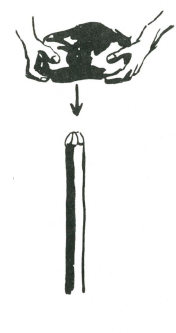BARKS
The inner bark of many shrubs and trees, alive or dead, also makes excellent lashing material. Strip down to the required thickness, but watch out for weak places.
SPECIAL KNOTS
Many of the sedges have length and strength and may be used for lashing and sewing work.
Nearly all the bulrushes can serve as lashings, and many of the “sword grasses” or sedges, but be careful handling these, as the razor-sharp edge can make nasty little cuts in your skin which poison easily. If handling any of the sword grasses, put a pair of socks on your hands and so save your skin.
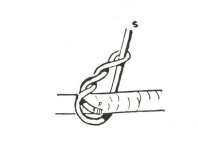
SEDGES AND BULRUSHES
These green materials require special knots if they are to be used to best advantage. For example, the customary start of a square lashing is with a clove hitch (see also Chapter 6 “Knots and Lashings”), but a clove hitch on “green” bush material is useless. The natural springiness in the material will cause the start of the knot to open. ALWAYS start a lashing with a timber hitch, as shown above.

And ALWAYS see that the free end passes straight through the “eye” and does not come back against the eye. If it does, it will probably cut itself.

Start your lashing with a timber hitch, as Fig. 1; make three to six complete turns around the two poles, and “work” them together as you tighten the lashing at each turn (Fig. 2).
The trapping turns (Fig. 3) follow. These trapping turns close the lashing in, and tighten the whole job. Finish off by passing the free end of the material through an opening of the lashing and finish with a couple of half hitches pulled tight.
JOINING GREEN MATERIALS
An overhand knot (Fig. 1) will often serve, but if the material “cuts,” try a sheet bend (Fig. 2) or a reef knot (Fig. 3). There are many ways of joining green materials either by plaiting or by spinning into rope. These are fully explained in Chapters 1 and 6.
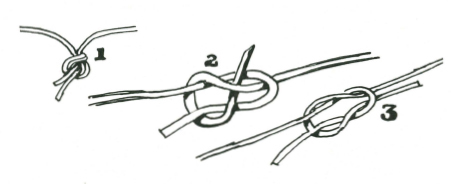
WALL PEGS

Wall pegs, and all stakes which are to be driven into the ground, must be straight, have the head bevelled and the foot pointed. This is shown on the illustration on the left. Avoid pointing with a single cut, as illustrated on right.
CHAPTER 3
CAMPCRAFT
With the only tool, a machete or a sharp knife, it is practical and easy to set up a camp in comfort. Everything one needs for bed, table, seats and chairs, cooking, and even lighting is usually available in the area immediately around the camp.
A small amount of knowledge is needed and some of this is given in this book.
Campcraft, like all the other skills in bushcraft develops the powers of observation to a remarkable degree, and with this the ability to adapt or improvise.
It is applicable by all who camp, regardless of whether the camping is a once-a-year venture with a car and auto tent, or a weekend adventure with a pack on one’s back.
There need be no discomfort for anyone in camping if they have knowledge of how to set up a camp in comfort.
A properly made camp bed can be as restful as an inner spring mattress, and no food is more flavoursome than when cooked in the out-of-doors.
If the camper does not know how to camp in comfort there will be times during heavy rain when wood appears too wet to take fire, or when the wind is so high that the heat of the fire is blown under and away from the water in the billy the camper is trying to boil, or when ants or bush rats find the food supply.
This book shows many things you can do to make your camping more comfortable, and considerably safer.
PEGS AND STAKES
Campcraft without equipment is totally different from campcraft with equipment ... and in some ways, “doing without” can be more fun. This Bushcraft book shows things that you can make and do in camp when you have no equipment except a cutting tool. Some items will be new to even the most experienced camper, and there will be much that is of value to the Boy Scout and his brother in woodcraft.
Camping without equipment calls for a really sharp tool, and a good deal of common sense. A good machete is probably the most useful of all tools for bush work. Mostly you will want sticks, either for pegs or stakes, or forks or hooks, and these generally can be cut from windblown branches close to the site of your camp. It is always preferable to use dead timber rather than growing wood. By using dead (but not rotten) wood you are clearing the forest floor of debris, and by avoiding cutting green wood you are helping to conserve the forests.
BUSH CAMPCRAFT
Even a simple item like a stake or a peg must be cut properly, and if it is to be driven into the ground it must have the head bevelled and the toe properly pointed.
THIS IS THE RIGHT WAY
![]()
This stake will drive cleanly into the ground. It will not split when being driven because the head is properly bevelled.
THESE ARE WRONG
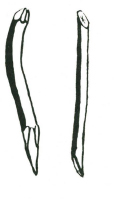
Both these stakes will be a failure. One will not drive because it has a bend, and this deflects the blow. The other will either split at the head, or drive crooked, because the toe is cut at an angle.
FORKS
Generally the correct sort of fork to select is one with a perfectly straight drive from the head to the toe, and with the forked stick coming off at an angle. A fork which is to be driven into the ground must have the head bevelled and the toe pointed.
THIS FORK IS CORRECT
THESE FORKS ARE WRONG

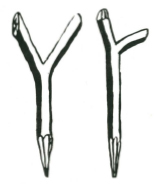
There is a perfectly straight drive from the bevelled head right through to the toe. This fork will drive into the ground and stand securely.
These forks cannot be driven. Left: If you try to hit one of the forks, the blow will be deflected by the angle. If you try to hit in the crotch, the fork will split.
Right: Because the main stick is not straight, this fork will not go into the ground.
Most beginners think that the wrong way will work out all right . . . everyone does . . .the first time; then you learn that it pays to spend five minutes finding the right shaped stake or fork, rather than trying-to make do with a poorly selected stick.
HOOKS
Unless hooks are to be driven into the ground, less care is required for their selection.
THIS HOOK WILL DO THE JOB
AND SO WILL THIS
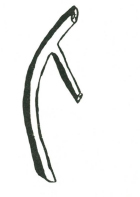
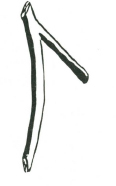
After you have selected the stake, fork or hook, and before you trim it, make sure that the wood, though dead, is not rotten. The inner wood must be sound.
DRIVING STAKES
